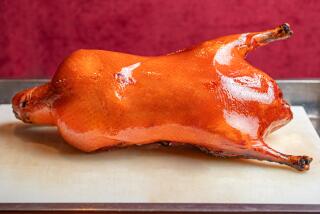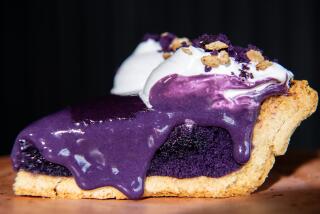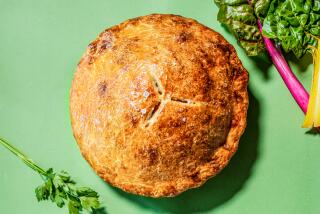Roasted duck pot pie
- Share via
Total time: About 5 1/2 hours, including roasting and baking time
Servings: 10
Note: From test kitchen director Donna Deane. Duck fat (if you would rather buy it than render it from the duck) is available at Bristol Farms stores, Surfas in Culver City and Monsieur Marcel in Los Angeles. This recipe calls for a 2-quart, 4-inch deep casserole.
1 (5-pound) duck
2 tablespoons olive oil, divided
Salt to taste
2 carrots, peeled, roughly chopped
1 medium onion, roughly chopped
1 celery stalk, roughly chopped
2 sprigs thyme
4 to 5 black peppercorns
1 teaspoon salt
2 cups torn kale (torn in bite-size pieces)
4 small carrots, peeled and sliced ( 1/4 inch on the
diagonal)
4 turnips peeled and cut in 3/4-inch cubes
1 tablespoon butter
1/3 cup flour
1/4 cup duck fat
1. Heat the oven to 425 degrees. Rinse the cavity of the duck well under cold running water until the water runs clear. Set aside all giblets but the liver (discard the liver) for making stock. Pat the duck dry and rub about 1 tablespoon of the olive oil on the outside of the duck. Season with salt.
2. In a roasting pan, toss the carrots, onion, celery and thyme with the remaining 1 tablespoon olive oil. Place the duck on top of the vegetables; roast for 15 minutes. Reduce the oven temperature to 350 degrees and continue to roast an additional 1 hour to 1 hour, 20 minutes until a thermometer inserted in the thigh reaches 145 degrees. (The meat will be pink.) Remove the duck from the oven and let stand until cool enough to handle.
3. For the duck fat, strain the roasting juices from the pan and skim the fat from the juices (you should have two-thirds cup fat for the crust). Place it in the freezer until the fat completely solidifies, about 2 hours. Once the roasted duck has cooled, remove skin and fat. Tear the skin into pieces and place it in a heavy-bottomed saucepan. Cook over low heat to render the fat, about 1 1/2 hours. Strain fat and set aside. You’ll need about a one-fourth cup fat for the roux for the filling. If you’re short of fat, you can add butter.
4. Meanwhile, remove the duck meat from the carcass; set aside the carcass for stock. Shred the meat into bite-size pieces. Cover and set aside.
5. For the stock, scrape the roasted vegetables along with any drippings into a saucepot. Add the reserved giblets along with the duck carcass from roasting the duck. Add 10 cups water, black peppercorns and 1 teaspoon salt. Bring to a boil. Reduce the heat and simmer about 1 1/2 hours. Skim off the excess fat as the stock cooks. Remove from the heat and strain the stock through a fine mesh strainer. Rinse the saucepot and pour the strained broth back into the pan. Bring to a boil and reduce until the stock measures about 4 cups.
6. Prepare the vegetables. In a clean pot, blanch the kale in boiling salted water about 1 minute, drain well and set aside. In a sauté or frying pan, cook sliced carrots and turnips in 1 tablespoon butter over medium-high heat until just tender, 7 to 8 minutes.
7. For the roux, heat one-fourth cup duck fat in a small saucepan until hot. Stir or whisk in one-third cup flour and cook, stirring constantly, until smooth and bubbly. Simmer 2 to 3 minutes, then stir the roux into the hot stock. Heat and stir until the sauce is smooth. Bring to a boil over high heat, then reduce to a simmer. Season to taste with salt. Cook until the sauce thickens, about 5 minutes.
8. Stir the shredded duck along with sautéed vegetables and the kale into the sauce. Cover and keep warm.
Crust and assembly
2 cups flour
1 teaspoon salt
1/8 teaspoon freshly ground black pepper
2/3 cup cold duck fat, packed
4 tablespoons ice water
Milk for brushing on pastry
1. Heat the oven
to 400 degrees. Stir together the flour, salt and black pepper. Quickly cut in the cold duck fat with a pastry cutter or by hand until the fat forms pieces the size of small peas. Add the ice water a tablespoon at a time, tossing with a fork until the dough is moistened and it forms a ball. Shape the dough into a flat disc. The dough will be soft and easy to roll out on a heavily floured surface. Flour the rolling pin as well. (The dough should not be chilled. It will become crumbly and difficult to roll if chilled.)2. Lightly roll out the dough on a well-floured surface into an 11-inch circle. (The dough is easy to patch if necessary.) Using a 1-inch round cutter, cut a hole in the center of the dough.
3. Spoon the hot duck filling into a casserole. Roll the rolled dough partly around a rolling pin and gently lift it onto the top of the dish. Use a fork to seal the crust to the rim of the dish and trim any excess. Brush the pastry with milk. Put the casserole on a foil-lined baking sheet to catch any drips. Bake about 45 minutes until it is golden brown.
Each serving: 432 calories; 17 grams protein; 27 grams carbohydrates; 2 grams fiber; 28 grams fat; 9 grams saturated fat; 78 mg. cholesterol; 549 mg. sodium.
More to Read
Eat your way across L.A.
Get our weekly Tasting Notes newsletter for reviews, news and more.
You may occasionally receive promotional content from the Los Angeles Times.










